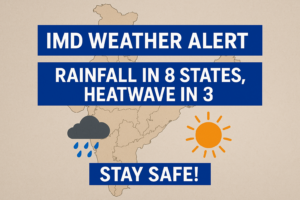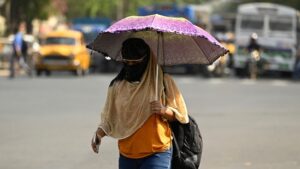India’s climate has again made a dramatic shift, highlighting its rich climatic contrast. On Thursday, the India Meteorological Department (IMD) released a major weather advisory warning citizens about two major climatic conditions-heavy rain in eight states and extreme heat wave in three states. This follows as the nation is shifting from the severity of summer into the beginning of the pre-monsoon period, a time that has come to be associated with both relief and danger.

Heavy Rainfall Warning for Eight States
According to IMD’s report, the states likely to be hit by heavy rain include Arunachal Pradesh, Assam, Meghalaya, Bihar, West Bengal, Sikkim, Tamil Nadu, and Kerala. These areas, with a wide geographical expanse from the northeast to the southern coastal regions, are under the grip of a low-pressure system and shifting wind patterns. The rain expected is not usual drizzles, it is heavy according to meteorological conditions and therefore some regions are likely to see rainfall ranging between 64.5 mm to 115.5 mm on a single day.

The north-eastern states such as Assam, Meghalaya, and Arunachal Pradesh are especially susceptible to heavy rainfall because of the terrain and climatic environment they are located in. The rolling landscape of the region heightens the danger of landslips, road congestion, and overflows of rivers. Along with this, urban areas like Guwahati and Itanagar can have temporary flooding in low-lying regions.
While, in the eastern states of Bihar, West Bengal, and Sikkim, the rain and thunderstorm together can pose inconvenience to transportation, power, and mobile connectivity. The southernmost states, Tamil Nadu and Kerala, will also see heavy rain, which may bring relief from summer temperatures as well as the risk of localized flooding, particularly in coastal districts or those with poor drainage.
Severe Heat Wave Conditions in Rajasthan, Madhya Pradesh, and Gujarat
While rain is going to take over the skies in the east and south, the western and central regions of India are entering perilously hot ground. IMD has issued a warning that Rajasthan, Madhya Pradesh, and Gujarat will be experiencing a severe heat wave on Thursday, with temperatures expected to rise above 45°C in some regions.
These high temperatures are mostly brought about by dry continental winds, clear skies, and the lack of any rains to bring much-needed cooling relief. Rajasthan, which is predominantly desert landscape, understandably sees hot summers. The ongoing heat wave, however, should drive temperatures to alarming levels, making exposure outside risky and unhealthy.

Madhya Pradesh and Gujarat are also slated to endure extreme heat, impacting not only public health but also water resources and agriculture. Rising temperatures speed up the depletion of groundwater and put pressure on electricity supply with additional use of fans, coolers, and air conditioners. In rural regions, this typically leads to power outages and shortages of water, further worsening residents’ misery.
The Science Behind These Contrasting Weather Events
This sharp contrast of weather patterns within the country directly owes to the diversified topography of India and changing climatic systems. While the pre-monsoon becomes stronger, the local weather systems start influencing the global climatic forces like the El Niño–Southern Oscillation (ENSO), the western disturbances, and the humid winds from the Bay of Bengal and the Arabian Sea. The systems account for short durations of rainfall, particularly in the east and coastal regions.
Meanwhile, the lack of any cloud cover or western disturbance in the northwestern plains enables temperatures to rise dramatically. Dry air masses and hot winds from the Thar Desert sweep through Rajasthan and neighboring states, providing perfect conditions for a heat wave. April is especially famous for this kind of weather contrast as various parts of India react differently to seasonal changes.
Implications for Daily Life and Agriculture
The consequences of such weather extremes are varied. In areas anticipating heavy rains, daily travelers could be disrupted by waterlogging and traffic jams. Rural communities could be hindered from accessing basic services if roads become flooded or communication lines are disrupted.
There is also the risk of landslides in hilly areas, particularly in Sikkim and sections of Arunachal Pradesh. Agriculturalists, however, will greet the rains, but up to manageable capacities only. Prolonged rain washes away seeds, destroys standing crops, and hinders sowing operations for the next cycle.
In contrast, areas under heat wave warning are experiencing an altogether different set of problems. Continual exposure to such temperatures augments the dangers of dehydration, heat exhaustion, and even heat stroke. Public health systems need to be equipped to handle increased patient volume, especially among vulnerable populations such as the elderly, children, and individuals with respiratory or cardiac illnesses. Moreover, water and energy resources can be subjected to long-term strain if the heat wave is prolonged.
Government Response and Public Safety
Considering the alerts, local administrations and state governments have been placed on stand-by. Emergency teams could be stationed in sensitive regions, and public awareness can be heightened through health departments with community outreach and the media. Outdoor activities might be halted or school timings modified to limit exposure in certain districts.
People are urged to pay close attention to IMD updates and adhere to any safety advisories that may be issued by local authorities. Residents in rain-hit areas should stay indoors during intense rain showers, while residents in heat-hit areas should remain indoors during the hottest part of the day and drink plenty of water.
Read Also : Ghibli Art: AI Vs Traditional
The shifting weather trend is also a pointer to the fact that the nation is in the pre-monsoon stage. Weather scientists are observing sea conditions and wind patterns vigilantly, for they will determine when and how vigorously the southwest monsoon makes an appearance in the first week of June. The IMD’s forecast, coming in the next fortnight or so, will provide vital insights for farmers, policy makers, and city planners from all parts of the country.
The climate in various parts of India is still a complicated blend of the natural geography of the place and what is happening climatically around the world. The two alerts—torrential rain in some areas, and fierce heat in other locations—highlight that climate variability is increasing and our level of preparedness should be a priority! Whether that is staying safe when caught in a thunderstorm or managing your health during a heat wave, knowing what to expect and preventative measures to take will go a long way in mitigating the impact of these events.
